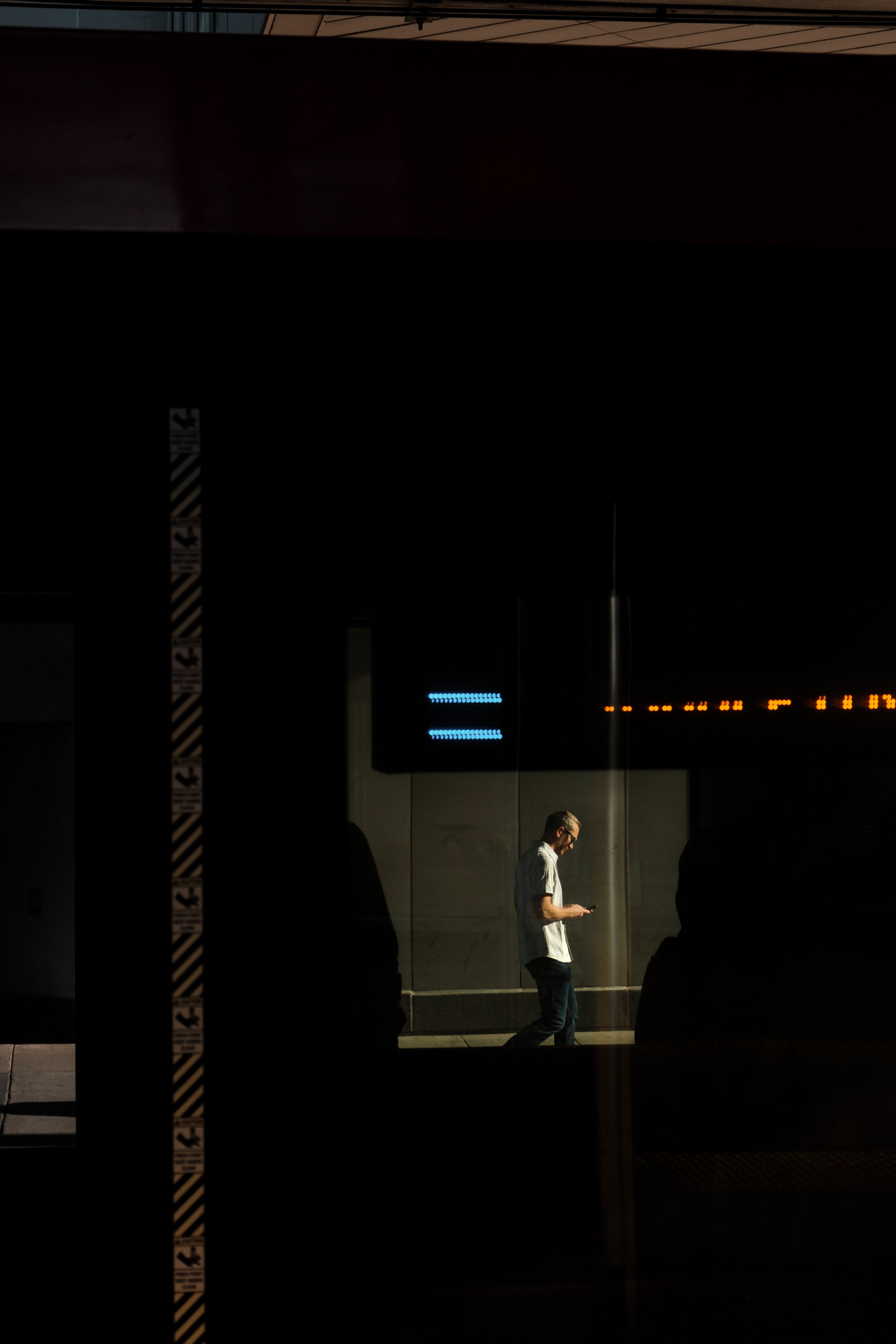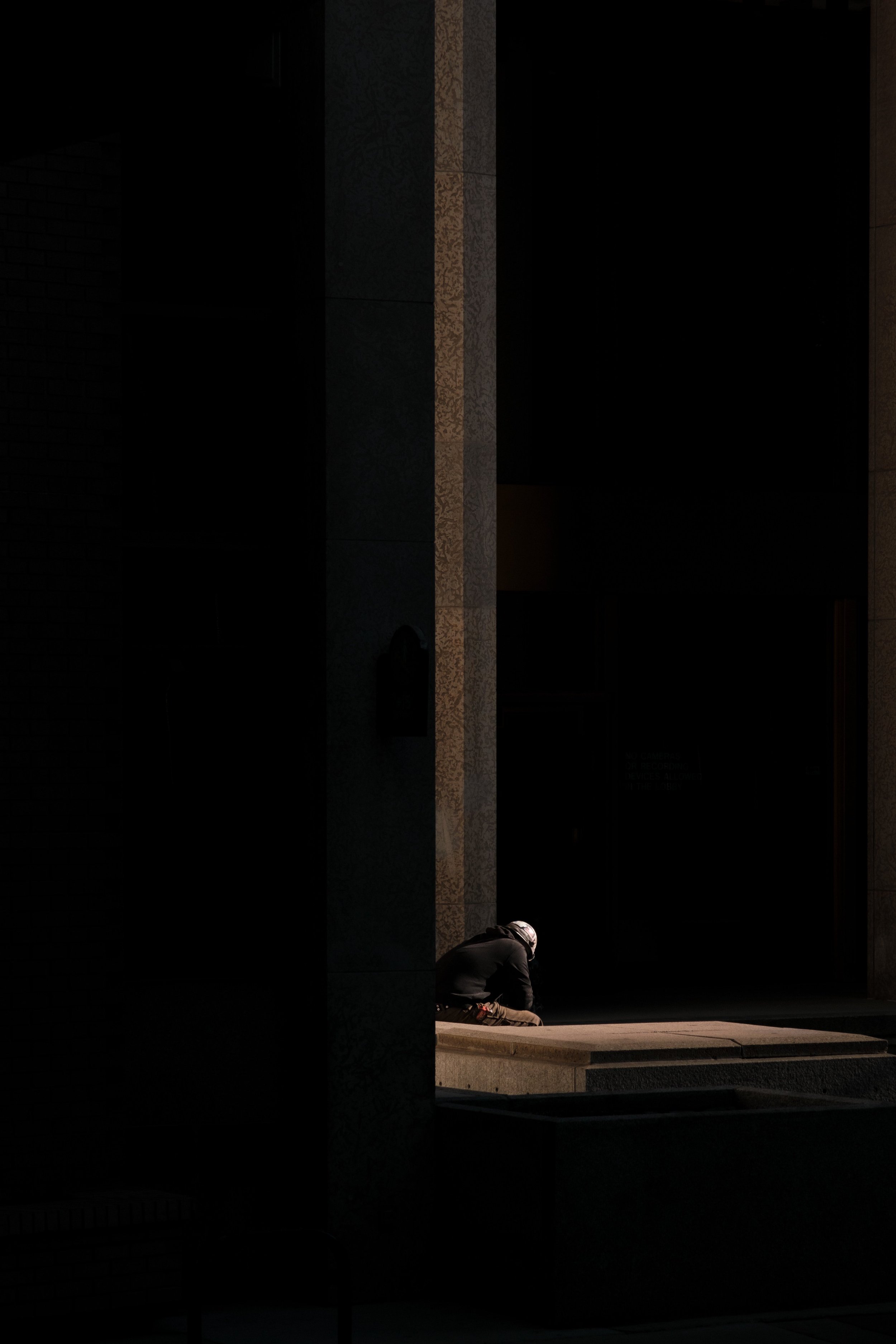Why am I making these photographs?
Trying to write about my work has been a massive struggle lately. This blog entry is a first-person account of what working through that has been like.
Self Portrait: October 1, 2022. All images in this blog entry: © Tyler A.W. Burke. 2022.
After two years of shooting a particular kind of street photography nearly everyday - allowing feeling and intuition to lead the way - I’ve had to take a step back to understand and articulate my own mostly-unconscious creative workings. Why am I making these photographs? The prompt: I have been writing and re-writing a proposal to potentially make my 2020-2022 street photography into a photobook.
A Casual Setting. © Tyler A.W. Burke. 2022.
The time I first picked up a camera, photography felt like a match: like putting the always-spinning cog of my mind into suitable set of gears. Back then, I relentlessly documented road-trips and my everyday surroundings (to the frequent chagrin of those with me - I was still learning how to use an SLR and it took me forever to make the camera do what I wanted); when a relationship ended around that time, I kept myself occupied on weekends by driving around southern Alberta photographing crumbling barns, listening to music, and submerging myself in the process. These rural excursions marked my first pseudo-project with photography and cemented my obsession with the medium (the logo I use today is rendered from one of those early photographs - and another is viewable below). Most of those barns have since fallen or been destroyed; I had been capturing small pieces of physical history that have since disappeared.
Done Got Old. © Tyler A.W. Burke. 2014.
My first couple dozen attempts to write the proposal leaned too heavily on a jumble of philosophical concepts that did little to draw the work together in a communicable way. After submitting a version of one of these project summaries along with some photography for a written portfolio review this summer, I received back the feedback that the photography was indeed speaking well for itself but my written summary was not on par. I was even more at a loss for words.
After the Closure. © Tyler A.W. Burke. 2022.
I erased everything I had and started over - this time thinking more about my personal journey with photography - and with life. I was reminded of the sense of discovery I felt when I first began exploring Calgary for myself as a young adult: finding interesting cafés, music venues, and shops in older buildings in Kensignton, Inglewood, and the Beltline. I was beginning to get a sense of the character this city had to pass down, and I felt connected to it - the good, bad, and ugly. When I first moved out of my parents’ house, it was with my bandmates into a West Hillhurst house built in the 1930s; my room had huge windows thin with age and it was stifling in the summer and freezing in the winter, the basement flooded when it rained heavily, and the porch was falling apart. Our energy bills were untenable in the winter when we had to purchase and run a big oil space heater to keep from freezing during rehearsals. It was not a plush, comfortable place to live by modern standards, but that was not really the point. Perhaps in part due to the charm of these inconveniences, I loved it.
When we eventually went our separate ways, the owners demolished the house within months and began work on a big, blocky, unmistakably ‘modern’ infill. Likewise, most of those old cafés, music venues, and shops have since been demolished, and in many instances ugly condo-commercial buildings now occupy every possible square inch of the plots. This trend must have been running in the background of my mind as I began my street photography practice. My growing alienation from a place so generic-ified and so lacking in character as Calgary’s downtown core is on display in many of my street photographs. I think I’ve always seen the value in the old, the imperfect, the worn-in, but this is not a city that shares this perspective. There are not many places left here that have not been infilled (I have been trying to photograph a few remainders these past couple weeks - see The Blue Store below).
The Blue Store. © Tyler A.W. Burke. 2022.
Without warm character spaces, surrounded on all sides by tall, high-efficiency concrete, glass, and steel, one is easily alienated and left to simply, conveniently do their work, complete another commute, and persist through the coextensive depression, pointlessness, or worse. Beneath the Pillars, Through the Blue-Line, and Breaks (shared below) are photographs I made this summer that show this persistence in the face of rampant environmental characterlessness here in Calgary.
To draw an analogy between that first rural photography project and my recent street photography: it’s like I missed my opportunity to photograph the remains of previous eras here. Instead of documenting the stoic remains of inherited character spaces, I am photographing what exists after these have all been destroyed and replaced. The replacements are designed to be efficient rather than beautiful and so we residents and commuters merely run our lives alongside - rather than in a more intimate relation to - these spaces and buildings.
The Long Walk Back to the Start. © Tyler A.W. Burke. 2022.
Last Christmas my partner bought me a photobook I had wanted for a long time: Modern Colour by Fred Herzog. I have been spending quite a bit of time going through this book recently. Not only was Herzog a pioneer of colour street photography, but he also spent most of his street career photographing a western Canadian city. The work in Modern Colour - most of it documenting the 1950s and 60s in Vancouver, British Columbia - captures the state of a city before a hurricane of convenience, efficiency, and gentrification destroyed most of those worn-in, character-imbued spaces; these spaces now only persist through photography. I feel like my own work these last couple years has been carrying on from Modern Colour, but after the fall, so to speak.
Modern Colour by Fred Herzog. Photograph by Tyler A.W. Burke. 2022.
There is a certain sense of romanticism (for lack of a better word) required to see the value of the aged, the imperfect, the weathered; the current social paradigm in the western world has all but abandoned this romanticism for the cold logic of profit and ‘progress.’ Why repair what can be replaced quickly and cheaply: I feel like this could easily be the slogan for Calgary’s downtown core and the western world writ large in the early 2020s. This seems to be the result of an over-valuation of one inherent mode of consciousness over another that dates back at least as far as Plato. Where the logical, the rational, and the individual have been valued over - and divorced from - the intuitive, the emotional, and the contextual, an unbalanced, unnatural, and un-affecting environment was bound to be the result.
This blog post has been me playing a bit of (constructive) hooky from finishing a book proposal, but I’m not sure the project is ready to be wrapped up quite yet. I feel like there is more work to be done to document the few spaces remaining around the city that show, by way of comparison, what exactly the cost has been of the city’s so-called progress. I’m hoping to turn to this focus over the course of this autumn before returning to the task of amalgamation.
I hope you’ll continue along with me on this journey: my Weekly Check-In via email newsletter (subscribe for free below) and my Instagram and/or Twitter (also linked below) remain the best ways to do so. If you want to discuss any of the topics or ideas I’ve touched on in this entry, feel free to send me a message via the contact page.
Until next time, take care,











